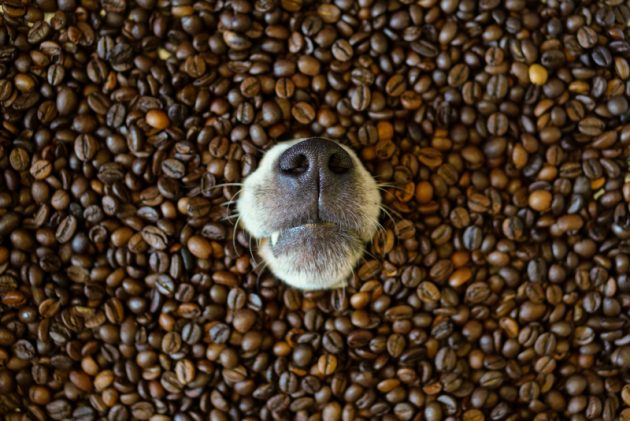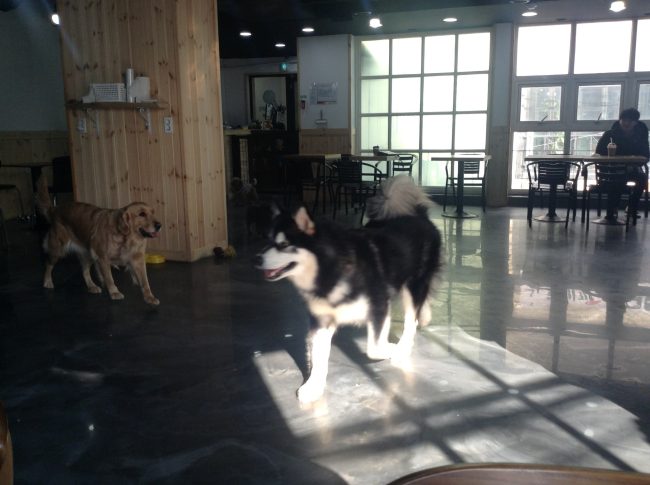
Hang on as we take a sip of the java in front of us…..
Today – September 29 – is National Coffee Day, and to celebrate, many restaurants including Dunkin’ Donuts, McDonald’s, Krispy Kreme, and Starbucks have been offering free coffee or deep discounts.
Just don’t let the dog get in on the action. A lick or two of coffee won’t kill a dog, but ingesting unused coffee grounds or beans just might. Coffee toxicity in canines is “a thing,” and an immediate call to the veterinarian or the Pet Poison Helpline (855-213-6680) is warranted for medical advice. Following a year of Covid shutdowns om 2021, the Pet Poison Helpline reported a 220 percent increase in the calls they got that involved brewed coffee.
Smelling coffee, however, is ok, and in fact, many English Springer Spaniels, Labrador Retrievers, Cocker Spaniels, and Beagles have careers doing just that. These breeds have most traditionally been used as sniffer dogs to detect contraband that bad guys thought could be disguised with coffee beans.
Sorry, not sorry, bad guys.
No matter how hard one tries to conceal an imprinted scent on a trained dog, that scent will be the dog’s primary focus, and using food, wax, gasoline (and yes, coffee) to conceal something else won’t dissuade them. If a dog can find four kilos of black tar heroin in a cow manure bin after it had been hidden there for a week (this really happened), coffee isn’t a challenge for a trained dog.
A trained dog can not only distinguish different types of coffee beans, they can do it from several feet away. Their “method” is to move rapidly in a sweeping, side-to-side motion as they take in lots of shallow sniffs that sample the air. They go where the smell is strongest, and “zero in” on the scent by moving their head from side-to-side to stay on target.
As if this isn’t impressive enough, dogs can also detect small amounts of caffeine in coffee grounds even after it has been filtered through water.

A dog cafe in Korea, photo by CafeUploader – Own work, CC BY-SA 4.0, https://commons.wikimedia.org/w/index.php?curid=94912193
Training a dog to detect a substance starts by building up the dog’s scent profile. Much like the top, middle, and bottom notes of wine or a perfume, a dog can distinguish a range of smells, separating them from one, more dominant smell. We’ve always liked this analogy to explain a dog’s sense of smell: When even an untrained dog walks into a kitchen where a stew is cooking, they smell the stew, of course, but they also can smell the separate ingredients: They smell the carrots. They smell the meat. They smell the herbs. A sniffer dog trained to do the same thing with everything from plastic to drugs undergoes 600 to 800 hours of training before being ready to work, and then he or she has a working life of around 6 – 8 years.
Any dog, however, is welcomed at a “dog cafe” (note seamless pivot to a different topic). The rise and popularity of dog cafe/coffee shops has been noteworthy. These establishments combine the cozy ambiance of a coffee shop with the presence of dogs, some of which are owned by the businesses themselves, or brought by patrons to hang out with their owners or other dogs. And it’s especially popular with dog lovers who can’t have their own dog because of work or living constrictions. At such a cafe, they can get their “dog fix.”
The first known animal cafe was Cat Flower Garden which opened in 1998 in Taipei, Taiwan. The idea, however, really took off in Japan which presently has the most animal cafes in the world. The concept spread across East Asia, Europe and finally, North America where, as far as we know, the first dog cafe opened in Silver Lake, California (New York City got its first dog café in 2017). Some cafes promote the adoption of shelter dogs, but others are a good place to see a variety of dogs.
Happily, the concept of allowing dogs has spread to most coffee shops, not just “dog cafes,” and if you have a photo of your dog hanging out with you at a cafe or coffee shop, share below, and mention the name of the establishment and its city, we’d like to reward them with a free “plug” for their good sense to welcome dogs.
We leave you with a few coffee quotes:
“I sometimes get excited at night thinking of the coffee I’ll get to drink in the morning. Coffee is reason to wake up. There are other reasons, of course. But coffee is the incentive, at the very least.” – Annie Clark
“If it weren’t for the coffee, I’d have no identifiable personality whatsoever.” – Dave Letterman
“It is inhumane, in my opinion, to force people who have a genuine medical need for coffee to wait in line behind people who apparently view it as some kind of recreational activity.” – Dave Barry
“Science may never come up with a better office communication system than the coffee break.” – Earl Wilson
Image: Dog©/Dreamstime

Thanks for sharing this discussion on coffee toxicity and canines! Great discussion, thanks for highlighting this!
Thanks for the comment, Madison!